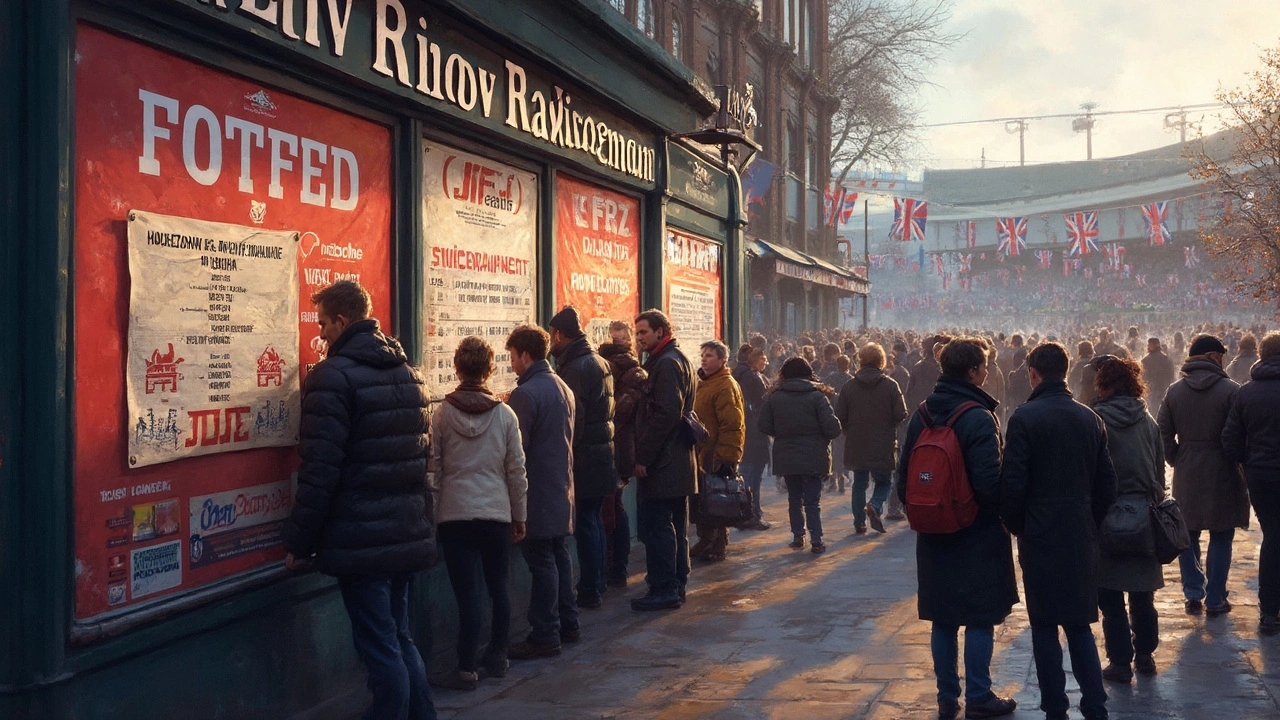Rugby Fixtures: Which Country Loves Rugby the Most?

If you had to guess where rugby is played the most, your mind probably jumps to places like New Zealand, England, or South Africa. That’s reasonable—they’re rugby-obsessed! But if we’re talking pure numbers, France actually edges out the competition with the largest number of registered rugby players in the world. The French rugby federation reported over 350,000 licensed players as of 2024, and that doesn’t even count all the casual backyard games.
France’s rugby love isn’t just about playing; their club scene is buzzing, especially in cities like Toulouse, Clermont, and Paris. If you ever get the chance, catching a game in any of those cities is wild—think singing crowds, face paint, and post-game street parties.
- Rugby's Kingpin—Country with the Most Players
- Hotspots: Other Nations Obsessed with Rugby
- Rugby Culture: Why Do Some Countries Play More?
- How Fixtures Drive Rugby’s Popularity
- Tips for Following Global Rugby Action
Rugby's Kingpin—Country with the Most Players
When it comes to sheer numbers, France sits at the top of the rugby world. According to official figures from the French Rugby Federation, the country now boasts over 350,000 registered players, making it the kingpin for player participation. This isn’t a recent jump, either—France has consistently reported high numbers year after year, outpacing even countries that often grab the spotlight for their international trophies.
The structure of French rugby has a lot to do with these numbers. Rugby is played in thousands of local clubs spread across big cities, small towns, and even tiny villages. From the youngest youth teams wearing their first pair of rugby boots, to the veterans still charging into tackles on Sunday afternoons, there’s hardly a corner of France where you won’t find people tossing a rugby ball.
School programs make a huge difference too. Many kids start playing rugby as part of their PE classes, and some schools join leagues that send teams to regular fixtures. This early exposure means lots of kids stick with the game long after school’s out. Plus, the country’s top league—the Top 14—draws big crowds and encourages young athletes to chase their rugby dreams locally instead of looking abroad.
Beyond the numbers, rugby in France is about community. Local clubs aren’t just sports centers; they’re spots for friends and families to gather, eat together after matches, and root for the home team. It’s easy to see why rugby keeps growing here!
So when you’re thinking about rugby fixtures across the globe, remember that France isn’t just producing top players, it’s hosting games packed with local talent almost every day of the week. If you’re planning a rugby trip or just want to watch the world’s most active scene, France is definitely the place to start.
Hotspots: Other Nations Obsessed with Rugby
France might top the stats, but you can’t talk about rugby without giving props to New Zealand. Over there, rugby isn’t just a sport—it’s a national obsession. The All Blacks, their national team, are worldwide icons. In fact, school kids in New Zealand grow up playing touch rugby, and you’d struggle to find a kid who doesn’t know what a scrum is. They’ve got just under 150,000 registered players, but the passion is off the charts.
Then there’s South Africa. If you’ve ever watched a Springboks Test match, you’ll understand why people say rugby is a religion in South Africa. With more than 600 clubs and schools pumping out players, their system fuels a constant supply of tough competitors. The 2019 Rugby World Cup win wasn’t just a victory for the team; it felt like a win for the whole country—a real unifier.
England deserves a mention for sheer volume, with around 340,000 registered players thanks to strong school and club leagues. Rugby matches in Twickenham Stadium draw some of the wildest, loudest crowds on earth. The vibe is contagious, especially during their famous Six Nations clashes.
Don’t sleep on Australia, either. They might split their sports loyalty with Aussie Rules and cricket, but rugby union and rugby league packs out stadiums from Sydney to Brisbane. The rivalry with New Zealand? Massive. And let’s not forget Fiji and Wales—two smaller nations where rugby pride runs deep. Fijians grow up with the ball in hand, and their flashy style is legendary. In Wales, rugby is practically sewn into the culture; even the non-fans seem to know what’s going on during international weekends.
- New Zealand: Famous for the All Blacks and a true rugby way of life.
- South Africa: Springboks unite the country every season.
- England: Huge numbers and fans that go all out, especially in Twickenham.
- Australia: Strong scene for both rugby league and union.
- Wales & Fiji: Small countries, huge influence—always a threat in world tournaments.
These nations aren’t just good—they’re mad about rugby. Eager players, passionate fans, and packed fixture lists keep the game alive and kicking way beyond just France.

Rugby Culture: Why Do Some Countries Play More?
What’s behind the rugby craze in places like New Zealand, France, and South Africa? It’s not just about talent—it’s about how the sport is woven into daily life. Some countries treat rugby almost like a rite of passage, while others squeeze it into the mix with football and cricket.
In New Zealand, rugby isn’t just a sport—it’s national identity. From rural schools to city parks, kids grow up with rugby balls in hand. The All Blacks, their national team, are a huge deal there. People actually schedule weddings around big matches because missing a game is unthinkable. According to World Rugby, about 8% of the population plays rugby—impressive for a small country.
Now, look at France. The rugby scene is stronger in the south than the north. Clubs like Toulouse, Toulon, and Clermont have long histories, and whole towns plan weekends around fixtures. The Top 14 league attracts thousands to the stadiums. Up North, England has a massive player base, but rugby is more of a private school legacy in some regions. That doesn’t stop over 2 million people in England from picking up a ball each season.
South Africa is a different story. Rugby was introduced by the British, but became a symbol of resistance and unity during rough times. After apartheid, the Springboks’ 1995 World Cup win pulled everyone together in a way no politician could. School and club rugby is huge, and you’ll see packed stands and backyard games all over the country.
Want to compare the numbers of registered players in these rugby hotspots? Here’s how the data looked in 2024:
| Country | Registered Players | Population | Players Per 1,000 People |
|---|---|---|---|
| France | 350,000+ | 68 million | ~5.1 |
| England | 2,000,000+ | 56 million | ~35.7 |
| New Zealand | 156,000+ | 5.2 million | ~30 |
| South Africa | 650,000+ | 60 million | ~10.8 |
The numbers can be misleading if you look only at totals. England’s schools push rugby hard, so loads of kids sign up at a young age. But in New Zealand, the percentage of players per population is off the charts, so you can feel rugby everywhere you go.
The bottom line? It often comes down to history, exposure at school, family traditions, and even climate—try playing rugby in countries with constant snow or blazing heat. Local clubs and national team success also get people buzzing for regular rugby fixtures. If your country’s team starts winning, suddenly everybody wants to play. That’s how culture keeps the flame going.
How Fixtures Drive Rugby’s Popularity
You can have a country full of rugby fans, but it’s the fixture list that actually gets people hyped every season. Fixtures aren’t just dates on a calendar—they’re the heart of fan culture, rivalry, and the reason millions block out whole afternoons just to watch a match. Think about it: a packed rugby fixtures calendar can turn even casual followers into die-hards by keeping the action nonstop.
Big international tournaments like the Six Nations, Rugby Championship, and Rugby World Cup send the sport’s popularity through the roof. During the Six Nations, for example, attendance and TV numbers in Europe skyrocket. The France vs. England showdown in 2024 pulled in over 80,000 fans to the Stade de France and millions more on TV. Club rugby in France and England keeps the buzz going too—Top 14 and Premiership Rugby have fixtures almost every weekend, which means loyal supporters always have something to look forward to.
Let’s break down how major fixtures boost the rugby scene in a few key countries:
- Rugby World Cup matches can attract stadium crowds of over 60,000, with 2023’s France vs. New Zealand opener drawing a TV audience of more than 15 million in France alone.
- South Africa’s United Rugby Championship games are basically weekend traditions—selling out stadiums and pulling massive local viewership.
- New Zealand’s All Blacks schedule is a national event—shops close, cities go quiet, and everyone tunes in.
Here’s a look at rugby match attendance and TV viewership for some of the biggest fixtures in 2024:
| Fixture | Stadium Attendance | Estimated TV Viewers |
|---|---|---|
| France vs. England (Six Nations, Stade de France) | 80,000+ | 10+ million (Europe) |
| New Zealand vs. South Africa (Rugby Championship) | 50,000+ | 8+ million |
| Stade Toulousain vs. La Rochelle (Top 14 Semi-Final) | 31,000 | 2+ million (France) |
| South Africa vs. Ireland (Test Match, Cape Town) | 60,000 | 4+ million |
If you’re tracking fixture lists, the best tip is to use the official league or tournament website—they’ll have the most up-to-date schedules and ticket info. Social media and team apps are goldmines too, dropping fixture reminders, streaming links, and behind-the-scenes content. Staying on top of the busy rugby fixtures calendar means you’ll never miss the games everybody’s talking about at work or over a pint.

Tips for Following Global Rugby Action
Keeping up with rugby around the world feels like a job sometimes. Fixtures happen year-round, from French clubs to the All Blacks, so the key is knowing where to look and what to track. If you want to stay on top of everything, here’s how you do it without losing your mind.
- Start with official websites. For worldwide rugby news and fixtures, World Rugby’s official page is a must. For national calendars, check sites like the RFU (England), NZ Rugby, or the French Rugby Federation. Most top national unions keep up-to-date schedules and results.
- Use rugby fixture apps. Apps like Ultimate Rugby and Rugby Pass bring together all major fixtures and live scores. You can set reminders for matches, so you never miss your favorite teams in action.
- Watch streaming platforms. Services such as Sky Sports, beIN Sports, or Stan Sport carry comprehensive rugby coverage depending on your country. Plus, a lot of clubs now stream matches live on YouTube or Facebook for free.
- Follow reliable rugby social media accounts. The Rugby World Cup, Six Nations, and official team accounts are goldmines for breaking news and highlight clips. X (formerly Twitter) is especially handy for real-time updates.
If you’re the sort who loves stats or detailed tables, this quick breakdown shows how much rugby goes on in some of the busiest countries, based on data from 2024:
| Country | Registered Players | Major League/Competition | Annual Fixtures |
|---|---|---|---|
| France | 350,000+ | Top 14 | 200+ |
| England | 340,000+ | Premiership Rugby | 180+ |
| New Zealand | 150,000+ | Super Rugby Pacific | 100+ |
| South Africa | 112,000+ | United Rugby Championship | 90+ |
Rugby is non-stop, so pick your favorite league or country and dig in. The more you follow, the easier it gets. And hey, if you ever end up planning your weekend around a rugby fixture, you’re not alone—just ask my mate Carly, who’s responsible for half our living room’s sports decor.



